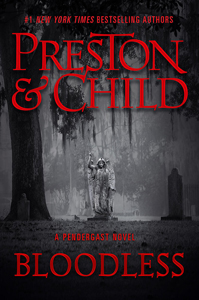Douglas Preston and Lincoln Child’s “Bloodless” (August, hardcover) explores their love and fascination with Savannah, a town architecturally trapped in time. But too many words state their love and not enough describe specifics. This is a better-than-average thriller, but not a masterpiece of unforgettable detail like “Relic,” “Cabinet of Curiosities” and “Still Life with Crows.”
A lot packed in
P&C are having fun writing together lately. Neither has written a solo novel since 2017, and this is their second team novel of 2021, after the Nora Kelly-starrer “The Scorpion’s Tail.” (The four previous times they published two team novels in one year, one of them was a Gideon Crew book.)
The fun is illustrated by how much they cram into this 20th Agent Pendergast novel: The Savannah Vampire, the D.B. Cooper mystery, paranormal investigators, a paranormal debunker, political buffoonery, multiverse theory … plus a little something about Pendergast and Constance.

“Bloodless” (2021)
Authors: Douglas Preston and Lincoln Child
Genres: Horror, science fiction
Series: Agent Pendergast No. 20
Setting: Savannah, 2021
I think “Bloodless” – although a page-turner that I savored — would’ve been better with fewer topics, and a more specific focus.
SPOILERS FOLLOW.
An elusive vampire
Notably, the Savannah Vampire legend is name-dropped but the legend is never actually told. I don’t even know if it’s a real thing or something the authors made up. (The web points me to a “Savannah Vampire” book series by Raven Hart, and broader Georgia bloodsucker lore.)
The Savannah Vampire gives way to H.P. Lovecraft meets “Fringe.” Pendergast goes into another dimension to fight the creature we originally suspected of being a vampire.
Previously, the weirdest science P&C have asked us to swallow is that Constance is ageless thanks to a successful medical experiment by Pendergast’s ancestor. The fascinating slow burn of that thread and the exploration of what it’s like for someone to be young in body and old in mind has made most readers forgive it – and embrace it.
Maybe that will happen with the multiverse idea as we follow Constance into the 19th century as she tries to save her sister. But in “Bloodless” itself, P&C are guilty of unabashed mad science.
The desire to explore multiverses and time travel similarly drove Michael Crichton in “Timeline,” where in the afterword he openly admits to straying from hard science. (Quantum theory points to multiverses; people traveling through them is a step much further. Crichton uses “quantum foam,” P&C use the machine from “Young Frankenstein.”)

Constance to the fore
Still, I suspect Constance’s time adventure will make this worthwhile. She deserves to be a focal character for the first time since the controversial “Obsidian Chamber,” where she’s defined by her horrible taste in men.
The standout character chapters in “Bloodless” find Constance talking to an old lady holed up on the fourth floor of a restored downtown hotel, suspected of being the Savannah Vampire. Constance sees her own future in the woman, and doesn’t like it.
Meanwhile, Pendergast and Coldmoon do their thing. Pendergast pulls off inexplicable feats such as booking a jaunt to the Pacific Northwest to dig into the Cooper legend. Coldmoon remains the exasperated audience surrogate. The authors pepper in more Lakota words this time, but Coldmoon’s characterization continues to be that he loves camp coffee and desires to get to his FBI post in Colorado.
Two camps of supporting characters stand out in “Bloodless.” Calling to mind the old Smithback-Harriman newspaper rivalry, we get paranormal documentarian Betts (and his team) against paranormal-debunker author Wellstone. These characters are broad and amusing (as is an arrogant Georgia senator running for re-election).
Amid Betts’ group is a German named Moller, who purports to use homemade devices to detect the paranormal. P&C have to tiptoe here, as we wonder if Moller is genuine. It leads to some awkward writing, because Wellstone debunks Moller fairly early in the game, which is necessary for Wellstone’s arc but tricky for keeping the suspense going.
Evocative writing
But the rivalry leads to the most evocatively written chapter. The documentary team invades a rotting and overgrown mausoleum at the edge of a cemetery. I wanted a richer dive into Savannah overall, but the writing of this location is excellent.
Spying from a distance, Wellstone thinks he’s seeing improvised fictional moviemaking. Until he isn’t so sure. I love the authors’ description of Wellstone going catatonic from fear, never speaking or writing again.
The Cooper mystery is also clever, a short story of tragic romance within a novel. But the protagonists — split up for decades by circumstance – don’t get a reunion.
Granted, “Bloodless” is a horror novel, so that melancholy end fits. But it also points to the book’s one flaw: It has lots of compelling, grounded ideas, but the one that steals the show — the multiverse trek — is the goofiest.
P&C fans are engaged in a devil’s bargain right now. We’re getting Pendergast novels at a faster clip than ever. But maybe if the authors spent more time on each novel, they’d achieve the evocative, intense detail of their elite efforts.

